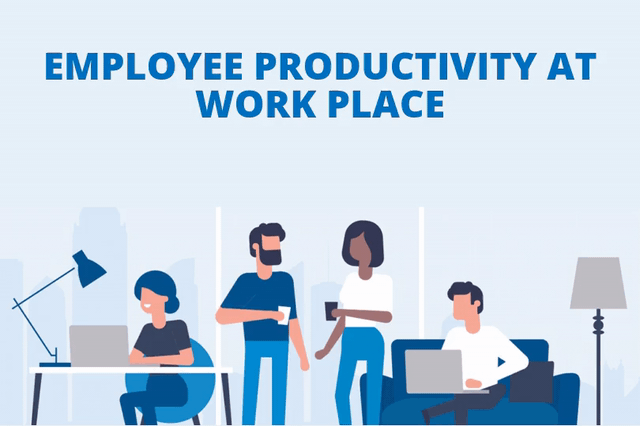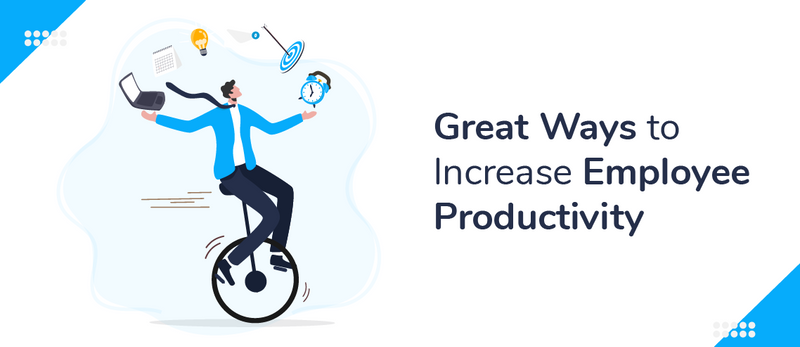Increasing employee productivity in the office can be difficult right now; the workplace has undergone some major changes in the last year, some of which may affect the way we work forever. It can be tough for many employees to adjust to this new manner of working.
To increase employee productivity, you must implement a strategy that motivates your team and inspires them to give their all in all they do.
Currently, workplace productivity and employee morale are challenging; many organizations are working from home, which means employees are prone to limitless distractions and a lack of connection can be detrimental to employee productivity.
Simply encouraging employees to be more productive will have no effect. In today’s job, you must be proactive in your thinking.
You must motivate your employee, demonstrate the benefits of workplace productivity, and show them how to maximize employee productivity.
Without further ado, here is your one-stop shop for increasing employee productivity.
What Is Employee Productivity?

Employee productivity is also known as workplace productivity or productivity in the workplace. It is a measure of an individual employee’s production.
A company that makes artistic bottles, for example, will want to know how many creative bottles one person can make in a given amount of time – this number is the individual employee’s output.
As a result, employee productivity should not be confused with labor productivity (workforce productivity), which is a country’s or company’s overall economic output per labor hour.
The Importance Of Employee Productivity
Because your employees are an essential element of your company, each team member should contribute to overall success by adding value to their roles. After all, it is the joint efforts of the entire employee that will propel the company ahead in the future.
Employee productivity is critical to any company’s success. It’s pointless to have the best people working for your firm if you can’t manage them properly and maximize their productivity.
Why Could Employee Productivity Be Low?

If you’ve noticed a productivity issue at work, the first step is to understand how productivity can be affected.
There are some things that influence productivity that is beyond your control. However, for the aspects over which you have control, you must assess the situation and determine how to handle the issues.
Workload
Employee productivity may be low because the workload you provide to them is either too light or too heavy. A heavy workload can be detrimental to one’s mental health, eventually leading to employee burnout. A minimal workload, on the other hand, might lead to boredom and exhaustion.
If there is a workload issue in your organization, it is critical to sit down with your employees and explore strategies to make the workload more manageable.
Use document management programs like Monday.com and Trello that may be connected to your workplace intranet platform. These apps enable you to construct a clear framework of things that must be accomplished and when they must be completed.
Team Motivation
Low morale and motivation are silent killers in the workplace, affecting an employee’s individual performance or even the performance of an entire team.
Employee morale is low when there is a shift in attitude, a lack of initiative, and poor performance.
If you see any of these variables in the workplace, you must address them immediately in order to boost employee productivity.
Top 10 Tips for Increasing Employee Productivity

Once you’ve determined why your worker productivity levels are low, the following step is to devise a solution. According to reports, 61% of employees are burned out at their current workplace.
In fact, burnout is a significant factor affecting employee productivity levels, and it is something that can be addressed head-on. We’ve compiled a list of 10 top recommendations for increasing workplace productivity, including a mix of immediate and long-term solutions.
1. Encourage Self-care
Encouraging employees to care for themselves goes a long way toward motivating them to care about their duties and projects.
- Encourage people to use their health insurance advantages – Make sure all of the company’s health benefits are known to employees and then encourage them to take advantage of the available full-physical exams, vaccines, and other perks.
- Provide useful self-care classes – You can enroll your employee in stress management or time management classes to assist them to learn how to reduce daily stress, better manage their time, or learn any other valuable self-care practices.
- Recognize employee achievements – It may appear to be sensible to approach your employees just when you need to point out errors in their work, but this is not a constructive strategy.
- Employees want to know that their efforts are recognized – 79% of professionals abandon their jobs owing to a lack of appreciation at work. Such a gesture boosts their confidence, therefore whenever possible, take the time to recognize people’s accomplishments and strong aspects.
2. Stop Micromanaging Everything.
Many leaders believe that micromanaging and allocating work to people would increase productivity, but this couldn’t be further from the truth. Employee empowerment occurs when a company trusts its employees to manage their own duties and day-to-day activities in the workplace.
Although many companies are afraid of allowing their employee to manage their own duties, empowered individuals are more likely to be effective.
3. Enhance Employee Onboarding
Many businesses still believe that once a contract is signed, their new employees’ loyalty is guaranteed. This typical working ethic no longer applies to new-generation talent. To properly incorporate them into the company culture, a comprehensive onboarding program is required.
An inadequate onboarding plan causes employers to lose 17% of their new recruits within the first 90 days. A good onboarding program, on the other hand, increases retention by 50%.
Extensive training, feedback, check-ins, and hands-on help are the fundamental components of good onboarding. A workplace intranet should also make it quick and easy for employees to learn as much about their coworkers as possible.
4. Promote Team Collaboration
Increased levels of innovation lead to higher levels of productivity and corporate growth. As a result, any firm wishing to fully engage with workers must establish a digital, collaborative workplace.
A mobile app for your company intranet is also a wonderful way to share company news with social feeds and timeline features – it allows your organization to adopt changes or collect valuable employee input, ultimately enhancing workforce efficiency.
5. Provide better employee training
Employee knowledge and performance are improved as a result of training and development.
- Make use of specialized software – Learning Management Software, such as Lynda or TalentLMS, offers a variety of relevant courses that assist employees in expanding on their existing talents and learning new ones. They also provide analytics and statistics to help you track the success of your employees.
- Give students hands-on experience –
- This allows employees to test the effectiveness of specific training assignments by allowing them to try them out as they learn about them.
- Employees should be allowed to study at their own speed – Rushing through complex topics will not allow new knowledge to stick or employees to put their newly acquired talents to the test. It is preferable to give employees enough time to comprehend their training or to study at their own pace.
6. Show Your Appreciation
Employees are motivated by recognition because it gives them a sense of success and makes them feel valued for their hard work and efforts. Not only does recognition make employees feel more confident in themselves, but it also increases workplace productivity.
When an employee receives appreciation for their efforts, it reinforces their behavior and increases their likelihood of continuing that behavior. Employee appreciation statistics speak for themselves: 72% of employees claimed they would work harder if they were recognized.
7. Improve Team Communication
All leaders understand that effective communication is essential to their success. According to a Smarp article, 72% of employees do not fully understand their firm’s strategy, making them feel alienated from their organization and out of the loop with vital company information.
Employee profiles also allow users to get to know one another on a more personal level, and they make it easier for management to get answers to questions about an employee’s activities in the virtual workspace, ultimately improving communication throughout the workplace.
8. Allow Flexible Work Schedules
Because different people have varied peak productivity times during the day, sticking to a strict 9-to-5 schedule or working hard from the wee hours of the morning may not be suitable for everyone.
Instead of working 8 continuous hours every day, divide the day into two smaller time chunks totaling 8 hours. Allow them to clock in from 7 a.m. to 1 p.m., go to the gym/take a long lunch, and then finish their workday from 3 p.m. to 5 p.m.
They’ll feel more productive and efficient since they’ll have more energy after the long, enjoyable 2-hour break, and they’ll escape the dreadful afternoon dip that employees experience before “close” time.
9. Value Transparency
When it comes to delegating work, it is critical for you as a leader to be clear and concise with your subordinates.
If you have a large project coming up, make sure to outline the assignment’s objectives to your staff; this way, they will be aware of what the task comprises, what is expected of them, and how they may measure their success.
10. Improve The Overall Condition Of The Workplace
If you want your staff to be productive, you must provide them with appropriate working conditions.
Make sure the office has lots of natural light. Employees who work in an office with windows and enough natural light sleep 46 minutes longer at night, which means they’re better rested and more likely to focus when they arrive at work.
Include greenery in the workplace. Green workplaces make employees feel more at ease and consequently more productive at work.
Don’t paint your walls white. Employees make more mistakes in offices with white walls; instead, choose red (which helps with detail-oriented tasks), green (which helps motivate), or blue.
Productivity Measurement Methods
Now that we’ve established how to boost productivity, it’s critical to understand how to successfully assess it. Productivity can be measured using the following metrics:
- Measuring the number of goals achieved
- Amount of work completed
- Quality of work completed
- Amount of time spent on a task
All of these approaches are critical to ensure that your worker productivity remains at its peak.
Conclusion
Once you understand the significance of employee productivity to the success of your firm, you must take the necessary actions to measure, calculate, and, most importantly, enhance this vital corporate resource.
To accomplish this, you must pay equal attention to what is beneficial to your company and what is beneficial to your employees – ensure that you improve workplace conditions, optimize emailing and meetings, allow flexible employee schedules, provide optimal employee training, refrain from micromanaging everything, improve office communication, and encourage employee self-care.





